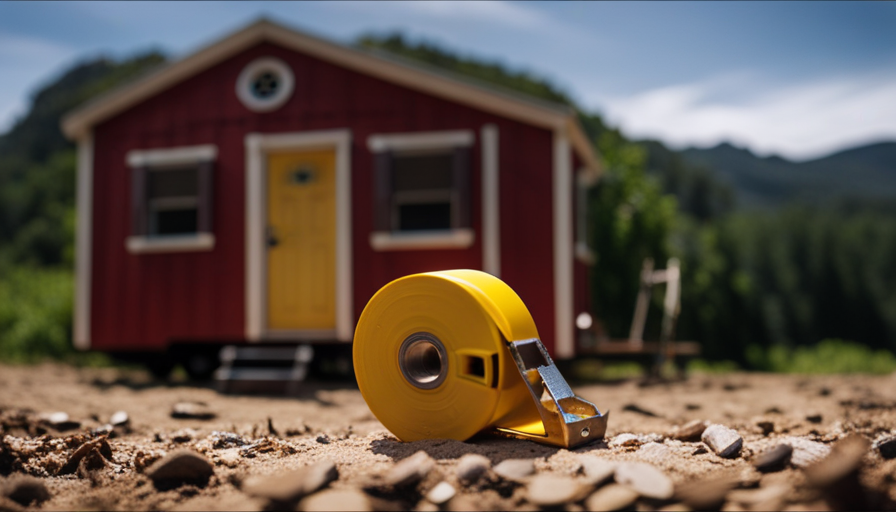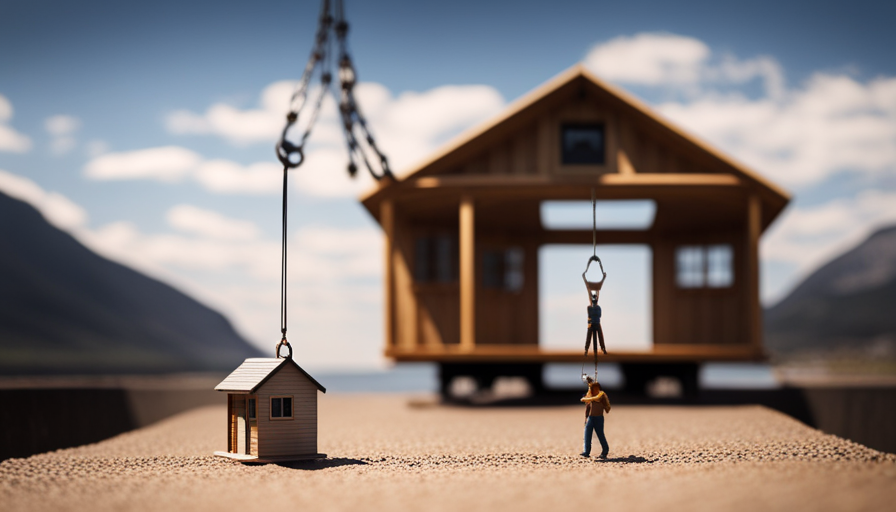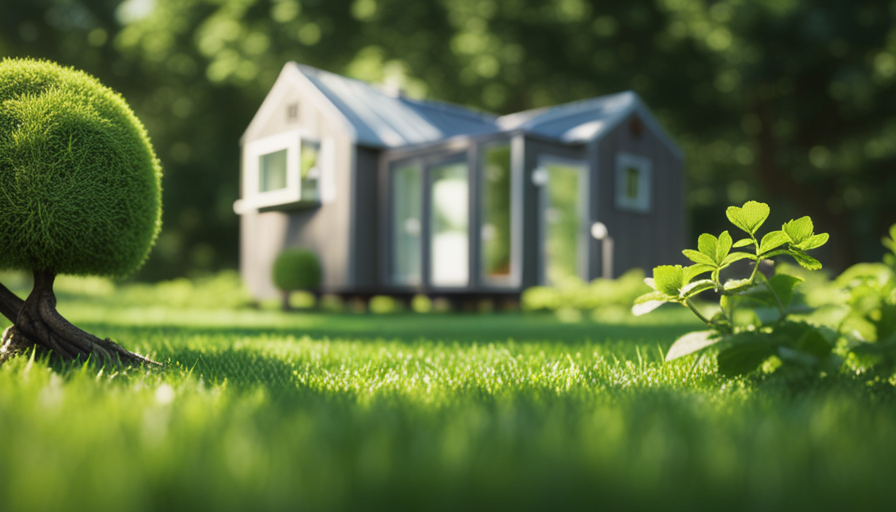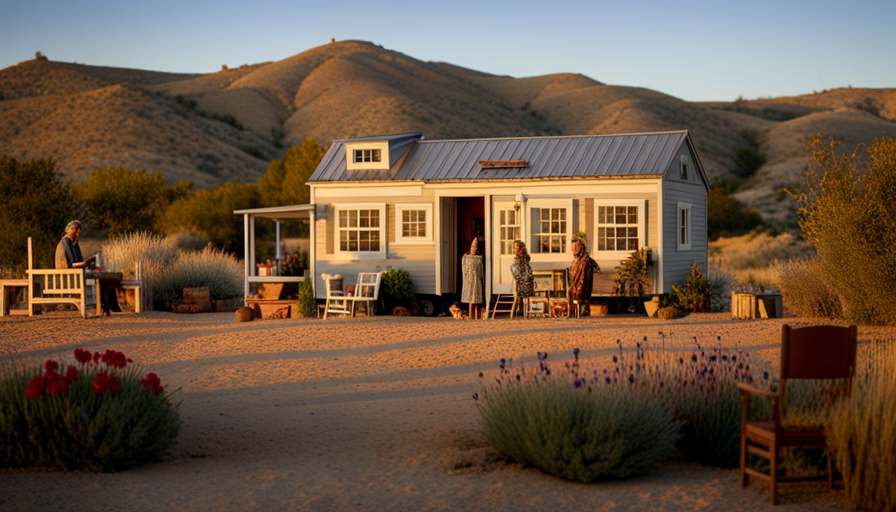Are you prepared for an astonishing discovery? Get ready, because I’m going to reveal a staggering truth that will amaze you. Imagine this: a small trailer home flying high above the earth, defying the laws of gravity and soaring to incredible altitudes.
Okay, maybe not that extreme, but have you ever wondered how high off the ground a tiny house trailer actually is? Well, get ready for a journey into the world of tiny house trailers, where we will unravel the secrets behind their height.
In this article, I will walk you through the basics of tiny house trailers, explore the regulations and guidelines governing their height, delve into the factors that affect their elevation, and reveal the common height measurements for these compact dwellings.
So, fasten your seatbelt and get ready to elevate your knowledge on this fascinating subject. Let’s dive in!
Key Takeaways
- Tiny house trailers have a maximum height allowance of 13’6" due to regulations and transportation limitations.
- Increasing the trailer height allows for more storage space, customization options, and design flexibility.
- Higher trailer heights improve stability during transportation and decrease the risk of tipping or swaying.
- Lower trailer heights can pose challenges for accessibility and mobility, but modifications can be made to accommodate these needs.
Understanding the Basics of Tiny House Trailers
The height of a tiny house trailer is a crucial factor to consider when understanding the basics of building a mobile home. When it comes to tiny house trailers, there are specific guidelines and regulations that need to be followed in order to ensure safety and compliance.
One important aspect to consider is the trailer weight capacity. This refers to the maximum amount of weight that the trailer can safely carry. It’s essential to choose a trailer with a weight capacity that can accommodate the weight of your tiny house, including all of its contents.
Another important consideration is the trailer axle placement. The axle placement determines the balance and stability of the trailer when it’s being towed. It’s important to position the axles correctly to distribute the weight evenly and prevent any tipping or swaying during transportation.
Understanding these basics will help ensure that your tiny house trailer is structurally sound and safe.
Moving on to trailer height regulations and guidelines, it’s important to be aware of the various rules and restrictions in place to ensure that your tiny house trailer meets the legal requirements.
Trailer Height Regulations and Guidelines
Take note of the regulations and guidelines for the height of your trailer when considering the dimensions of your compact dwelling on wheels. Trailer height restrictions and standards are in place to ensure the safety and functionality of tiny house trailers. It is important to comply with these regulations to avoid any legal issues or complications during transport.
To give you a clear understanding of the trailer height regulations, let’s take a look at the following table:
| Trailer Type | Maximum Height (inches) |
|---|---|
| Single Axle | 13’6" |
| Tandem Axle | 13’6" |
| Triple Axle | 13’6" |
As you can see, the maximum height allowed for all types of tiny house trailers is 13’6". This is a standard height restriction that is enforced to ensure the safe passage of your tiny house on the road.
Now that you are aware of the trailer height regulations and standards, let’s explore the factors that can affect the height of a tiny house trailer. These factors include the design of the tiny house, the type of foundation used, and the overall weight distribution. Understanding these factors will help you determine the optimal height for your tiny house trailer.
Without further ado, let’s delve into the factors affecting the height of a tiny house trailer.
Factors Affecting the Height of a Tiny House Trailer
Now let’s explore what factors can impact how tall your mobile home on wheels can be. When it comes to trailer height customization, there are several key factors to consider.
-
Building codes and regulations: Different states and municipalities have varying rules and regulations regarding the height of tiny house trailers. It’s essential to familiarize yourself with these guidelines to ensure compliance and avoid any potential legal issues.
-
Transportation limitations: The height of your tiny house trailer may be limited by transportation restrictions. For instance, bridges, tunnels, and overpasses may have height restrictions that you need to take into account during the design process.
-
Interior design considerations: The height of your trailer can significantly impact the interior design of your tiny house. A taller trailer allows for more vertical space, potentially accommodating loft areas, higher ceilings, and more storage options.
-
Overall stability and weight distribution: Increasing the height of your trailer can affect its stability and weight distribution. It’s crucial to work closely with an experienced engineer or builder to ensure that any modifications to the trailer’s height do not compromise its structural integrity.
Considering these factors, it’s important to carefully plan and evaluate the impact of trailer height customization on both the legal aspects and the interior design of your tiny house.
Transitioning into the subsequent section about common height measurements for tiny house trailers, it is essential to understand the standard measurements used in the industry.
Common Height Measurements for Tiny House Trailers
One important aspect to consider when customizing the height of your mobile home on wheels is understanding the common measurements used in the industry. Common height measurements for tiny house trailers typically range from 13 feet 6 inches to 14 feet. These measurements are based on regulations set by the Department of Transportation (DOT) in the United States, which limit the height of trailers to ensure safe transportation on public roads.
To emphasize the common height measurements for tiny house trailers, here is a table showcasing the range of heights:
| Measurement |
|---|
| 13 feet 6 inches |
| 13 feet 8 inches |
| 14 feet |
Raising the trailer height for increased storage is a common customization option for tiny house owners. By increasing the height, you can create additional space for storage cabinets, shelves, or even a loft area. However, it is important to consider the overall weight distribution and stability of the trailer when making modifications.
Understanding the common height measurements for tiny house trailers is crucial in determining the customization options available to you. Increasing the trailer height can provide numerous benefits, such as increased storage space and the possibility of incorporating additional features. By raising the height, you can maximize the functionality and livability of your tiny house on wheels.
Benefits of a Higher Trailer Height
Imagine the possibilities of having a taller mobile home on wheels – with an increased trailer height, you can unlock a whole new world of storage space and customization options.
When it comes to tiny house trailers, the benefits of a higher height cannot be overstated. Firstly, increased stability is a major advantage. A higher trailer height allows for a larger foundation, distributing the weight more evenly and decreasing the risk of tipping or swaying during transportation. This added stability not only ensures a safer journey but also provides peace of mind for the occupants.
Additionally, a taller trailer offers greater design flexibility. With more vertical space to work with, you can incorporate loft areas, mezzanines, or even multiple levels within your tiny house. This opens up a realm of possibilities when it comes to room layout and functionality. Furthermore, the increased height provides ample room for storage solutions. From overhead cabinets to built-in shelves, the extra vertical space allows you to maximize every inch of your tiny home.
Considerations for low trailer heights can also be important. However, it’s clear that opting for a higher trailer height provides increased stability and design flexibility, making it a desirable choice for those looking to create their dream tiny home on wheels.
Considerations for Low Trailer Heights
When considering low trailer heights for tiny houses, there are two key points to take into account: transportation and clearance issues, as well as accessibility and mobility challenges.
In terms of transportation and clearance, a lower trailer height may pose difficulties when navigating under bridges or through narrow roads.
Additionally, accessibility and mobility challenges arise when the trailer height is too low for individuals with limited mobility to enter or exit the tiny house easily.
Transportation and Clearance Issues
Transporting a tiny house trailer can be a challenge due to its height off the ground and potential clearance issues. When it comes to transportation restrictions, it’s important to consider the legal limits for height when moving a tiny house trailer.
These limits vary depending on the state and country, so it’s crucial to research and adhere to the specific regulations in your area. Additionally, building code compliance is another factor to consider. Some jurisdictions have specific requirements for the height of a tiny house trailer, so it’s essential to ensure that your tiny house meets these standards before moving it.
By carefully considering these transportation and building code restrictions, you can avoid any potential issues when transporting your tiny house trailer to its destination.
Now, let’s discuss the challenges of accessibility and mobility.
Accessibility and Mobility Challenges
Navigating a tiny house on wheels is like maneuvering a cozy cabin on a whimsical adventure. However, accessibility challenges can arise when it comes to mobility. The compact size of a tiny house trailer may present difficulties for individuals with limited mobility or those who require assistive devices.
To address these challenges, various design options can be considered. For example, ramps can be installed to provide a wheelchair-friendly entrance. Additionally, wider doorways and hallways can be incorporated to accommodate mobility aids. Furthermore, adjustable countertops and cabinets can be installed at accessible heights. These design modifications ensure that individuals with accessibility needs can comfortably move around and utilize the space in their tiny house.
Transitioning into the subsequent section about modifications and adjustments to trailer height, it is important to consider the various ways in which the height of the trailer can be modified to meet individual needs.
Modifications and Adjustments to Trailer Height
Modifications and adjustments to the trailer height of a tiny house emphasize the flexibility and customization options available to homeowners. When it comes to trailer height, there are regulations and guidelines that need to be followed to ensure safety and stability. Factors affecting the trailer height include transportation clearance, accessibility, and mobility challenges. Common measurements for tiny house trailers range from 12 to 32 inches off the ground.
To help you choose the right height for your tiny house trailer, consider the benefits and considerations. A higher trailer height allows for easier access and mobility underneath the house, making maintenance and repairs simpler. On the other hand, a lower trailer height provides better stability and reduces the risk of tipping over during transportation.
Experts provide some tips when it comes to choosing the right height for your tiny house trailer. Firstly, consider the local regulations and guidelines regarding trailer height. Secondly, assess your mobility and accessibility needs. Finally, consult with professionals who specialize in tiny house construction to ensure that your modifications and adjustments meet safety standards.
Considering the modifications and adjustments made to the trailer height, it is important to address safety and stability concerns for elevated trailers.
Safety and Stability Concerns for Elevated Trailers
Safety and stability can be a major concern when elevating trailers for tiny homes. Elevated trailer construction requires careful planning and execution to ensure the safety of the occupants. One of the primary safety precautions for elevated trailers is to ensure the trailer is structurally sound and can handle the additional weight and stress of the tiny home. This includes reinforcing the frame and axles, as well as using appropriate materials for the subfloor and walls.
Another important consideration is the height of the elevated trailer. The higher the trailer, the more potential there is for instability and safety risks. It is crucial to strike a balance between the desired height and the stability of the structure. Factors such as wind resistance, weight distribution, and the overall design of the tiny home must be taken into account.
To mitigate safety concerns, it is recommended to consult with professionals who specialize in elevated trailer construction. They can provide expert advice on the appropriate height for your specific tiny home design and location. By working closely with professionals and following safety guidelines, you can ensure a safe and stable elevated trailer for your tiny home.
Transitioning into the subsequent section about expert tips for choosing the right trailer height, it is important to consider various factors that can impact the safety and stability of an elevated trailer.
Expert Tips for Choosing the Right Trailer Height
When selecting the perfect height for your elevated trailer, envision a harmonious balance between the soaring structure and the sturdy foundation it rests upon. The height of your tiny house trailer plays a crucial role in determining its overall safety and stability. Here are some expert tips to help you choose the right trailer height for your tiny house:
-
Consider the intended use of your tiny house. Are you planning to travel frequently or park it permanently? This will affect the ideal height for your trailer.
-
Evaluate the height restrictions in the areas where you plan to take your tiny house. Some bridges, tunnels, and campsites may have limitations on the maximum height allowed.
-
Think about the interior design and functionality of your tiny house. Higher trailers provide more space underneath for storage or utility connections, while lower trailers offer easier access to the interior.
-
Assess the pros and cons of different trailer heights. Higher trailers offer better clearance and protection from flooding, but they can also be more challenging to tow and require additional stabilization.
Choosing the right height for your tiny house trailer involves careful consideration of various factors. In the next section, we will discuss the conclusion and final thoughts on tiny house trailer heights, providing you with a comprehensive understanding of this crucial decision.
Conclusion and Final Thoughts on Tiny House Trailer Heights
To wrap things up, it’s important to consider all the different elements at play when deciding on the perfect height for your compact abode on wheels. Not only does the height of your tiny house trailer affect its overall appearance, but it also impacts transportation challenges and design considerations. Let’s take a closer look at these factors in the table below:
| Transportation Challenges | Design Considerations |
|---|---|
| Low bridges and tunnels | Ceiling height |
| Overhead power lines | Window placement |
| Weight restrictions | Roof pitch |
| Wind resistance | Loft height |
| Clearance during travel | Exterior height |
When it comes to transportation challenges, a low bridge or tunnel can pose a significant obstacle for your tiny house trailer if it exceeds a certain height. Overhead power lines can also limit the height of your structure. Additionally, weight restrictions and wind resistance should be taken into account to ensure a safe and smooth journey.
Design considerations are equally important when determining the height of your tiny house trailer. The ceiling height will impact the overall comfort and functionality of your living space, while window placement should be strategically planned for natural light and ventilation. The roof pitch and loft height should also be considered to create a visually appealing and structurally sound design.
By carefully considering these transportation challenges and design considerations, you can determine the optimal height for your tiny house trailer that meets both practical and aesthetic requirements.
Frequently Asked Questions
Are there any legal restrictions on how high a tiny house trailer can be?
Yes, there are legal restrictions on the height of a tiny house trailer. These restrictions are in place due to safety concerns. The maximum height allowed for a tiny house trailer varies depending on the jurisdiction and local regulations. It’s important to adhere to these restrictions to ensure the safety of the occupants and others on the road. Violating these legal restrictions can result in fines and other penalties.
What are the potential safety concerns of having a higher trailer height?
Adjusting the height of a tiny house trailer can be likened to balancing on a tightrope without a safety net. Potential safety concerns arise when the trailer is raised too high, as it can lead to instability and a higher risk of tipping over.
The increased height also affects wind resistance and can make the trailer more susceptible to strong gusts. It’s crucial to carefully consider the trailer height adjustment to ensure the safety of the occupants and the structure itself.
Can the height of a tiny house trailer be modified or adjusted?
Yes, the height of a tiny house trailer can be modified or adjusted. Trailer height modifications are possible to accommodate specific needs or preferences. Adjusting the trailer height can be achieved through various methods, such as installing taller wheels or adding height-adjustable suspension systems. These modifications allow for flexibility in adapting the trailer to different situations, ensuring optimal clearance and stability. It’s important to consult with professionals to ensure proper adjustments and maintain safety standards.
Are there any benefits to having a lower trailer height?
There are several benefits to having a lower trailer height for a tiny house. One advantage is increased stability, as a lower center of gravity reduces the risk of tipping over.
Additionally, a lower height allows for easier transportation under bridges or through narrow roads. However, there are also some disadvantages, such as limited headspace and storage capacity.
It’s important to weigh these pros and cons when considering the height of a tiny house trailer.
What factors should be considered when choosing the right trailer height for a tiny house?
When considering the right trailer height for a tiny house, several factors come into play.
Trailer height considerations are crucial for both practicality and design purposes.
Practicality-wise, it affects transportation clearance, plumbing, and electrical systems installation, and storage space availability.
Design-wise, the trailer height affects the overall aesthetic, headroom, and the ability to accommodate features like lofts.
Thus, it is essential to meticulously assess all these factors to ensure a well-designed and functional tiny house.
Conclusion
In conclusion, after analyzing the various factors affecting the height of a tiny house trailer, it is clear that choosing the right trailer height is crucial for a successful tiny house project.
While some may argue that higher trailer heights can lead to stability concerns, it’s important to note that with proper modifications and adjustments, these concerns can be addressed effectively.
By understanding the regulations, guidelines, and expert tips, individuals can confidently select a trailer height that suits their needs and preferences.
So, don’t let the height hold you back, embrace the possibilities of a tiny house on wheels!
Hi, I’m Emma. I’m the Editor in Chief of Tiny House 43, a blog all about tiny houses. While tree houses are often associated with childhood, they can be the perfect adult retreat. They offer a cozy space to relax and unwind, surrounded by nature. And since they’re typically built on stilts or raised platforms, they offer stunning views that traditional homes simply can’t match. If you’re looking for a unique and romantic getaway, a tree house tiny house might just be the perfect option.










